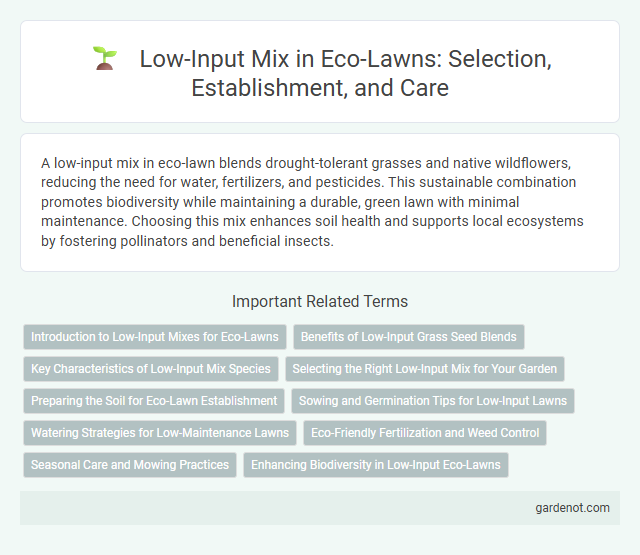A low-input mix in eco-lawn blends drought-tolerant grasses and native wildflowers, reducing the need for water, fertilizers, and pesticides. This sustainable combination promotes biodiversity while maintaining a durable, green lawn with minimal maintenance. Choosing this mix enhances soil health and supports local ecosystems by fostering pollinators and beneficial insects.
Introduction to Low-Input Mixes for Eco-Lawns
Low-input mixes for eco-lawns combine drought-tolerant grasses and native wildflowers that require minimal water and fertilizer, promoting sustainability and reducing maintenance costs. These mixes enhance biodiversity, support pollinators, and improve soil health by using deep-rooted species adapted to local climates. Selecting region-specific seed blends optimizes growth, resilience, and ecosystem benefits in low-resource landscapes.
Benefits of Low-Input Grass Seed Blends
Low-input grass seed blends reduce water consumption by up to 50%, promoting sustainability in lawn care. These eco-friendly mixes require minimal fertilization, enhancing soil health and lowering chemical runoff. Their drought-resistant and disease-tolerant varieties contribute to long-term savings on maintenance and resource use.
Key Characteristics of Low-Input Mix Species
Low-input mix species for eco-lawns exhibit drought tolerance, slow growth rates, and deep root systems that enhance soil stability and reduce water needs. Native grasses, such as buffalo grass (Bouteloua dactyloides) and fine fescues (Festuca spp.), dominate these mixes for their resilience and minimal maintenance requirements. Their ability to thrive with limited fertilization and mowing supports sustainable landscaping and biodiversity.
Selecting the Right Low-Input Mix for Your Garden
Selecting the right low-input mix for your eco-lawn enhances sustainability and reduces maintenance by promoting drought tolerance and minimal fertilizer needs. Opt for native grasses and clover varieties that adapt to local soil and climate conditions, ensuring robust growth with fewer resources. Incorporating drought-resistant species like fescues and buffalo grass supports water conservation while maintaining a healthy, green lawn throughout the seasons.
Preparing the Soil for Eco-Lawn Establishment
Preparing the soil for eco-lawn establishment begins with selecting a low-input seed mix tailored to local conditions, emphasizing drought-resistant and native grasses. Proper soil testing and amendment ensure optimal pH and nutrient levels, reducing the need for synthetic fertilizers. Minimal soil disturbance promotes beneficial microbial activity, fostering healthy root development and sustainable growth.
Sowing and Germination Tips for Low-Input Lawns
Sowing a low-input mix requires preparing well-drained, nutrient-poor soil to mimic natural conditions that favor drought-tolerant grasses and wildflowers. Seed should be evenly distributed at a rate of 20-30 lbs per 1,000 square feet, avoiding over-seeding which can increase competition and maintenance. Germination typically occurs within 10-21 days, with consistent moisture crucial during this stage to ensure uniform emergence and strong root development.
Watering Strategies for Low-Maintenance Lawns
Low-input eco-lawn mixes thrive with minimal watering by emphasizing drought-tolerant grass species like fine fescues and native grasses. Establishing deep root systems reduces irrigation frequency, promoting water conservation and soil health. Employing mulch and soil amendments further enhances moisture retention, supporting sustainable low-maintenance lawn care.
Eco-Friendly Fertilization and Weed Control
Low-input mix eco-lawns require minimal fertilization, utilizing organic and slow-release fertilizers to enhance soil health without chemical runoff. Eco-friendly weed control combines manual weeding, mulching, and natural herbicides to maintain plant diversity and reduce environmental impact. This sustainable approach supports water conservation and promotes biodiversity in residential and urban green spaces.
Seasonal Care and Mowing Practices
Low-input mix eco-lawns thrive with minimal fertilization and irrigation, promoting sustainability and reducing maintenance costs. Seasonal care involves adjusting mowing heights to 2.5-3 inches during spring and summer to encourage deep root growth and improve drought resistance. Mowing practices that prioritize less frequent, higher cuts support biodiversity by allowing wildflowers and native grasses to flourish throughout the growing season.
Enhancing Biodiversity in Low-Input Eco-Lawns
Low-input eco-lawn mixes prioritize native grass species and wildflowers that require minimal watering and fertilization, promoting sustainable growth while supporting local pollinators and beneficial insects. By incorporating diverse plant species such as fescues, clovers, and wildflowers, these lawns increase habitat variety and soil health, reducing maintenance and chemical use. Enhanced biodiversity in low-input eco-lawns contributes to resilient ecosystems, improved air quality, and reduced urban heat island effects.
Low-input mix Infographic

 gardenot.com
gardenot.com